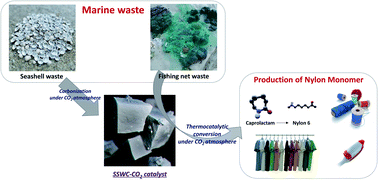Marine waste upcycling—recovery of nylon monomers from fishing net waste using seashell waste-derived catalysts in a CO2-mediated thermocatalytic process†
Abstract
A lot of fishing nets have been abandoned, lost, or discarded at sea. Herein, we aimed at applying seashell waste-derived catalytic materials to a thermocatalytic process to recover a valuable commodity chemical (e.g., caprolactam) from fishing net waste (FNW) made of polyamide 6. For catalyst synthesis, seashell waste was carbonized in N2 and CO2 environments (denoted as SSWC-N2 and SSWC-CO2, respectively); here, the basicity of SSWC-CO2 was two-fold more than that of SSWC-N2. The thermocatalytic conversion of FNW was also conducted under N2 and CO2 atmospheres. Using SSWC-CO2 in the thermocatalytic conversion conducted under a CO2 atmosphere maximized the caprolactam recovery (80 wt% of FNW feedstock, the highest yield reported to date) possibly because the base-catalyzed decomposition of polyamide 6 was enhanced by more reactive cleavage of the amide linkage in CO2. SSWC-CO2 was reused for at least three cycles. In conclusion, SSWC-CO2 is a promising alternative catalyst to recover caprolactam from FNW. The findings from this study offer insights into developing a new thermocatalytic upcycling process for marine waste such as FNW and seashell waste. This aids in reducing microplastic pollution and increasing economic potential for marine waste valorization.

- This article is part of the themed collections: 2023 Journal of Materials Chemistry A Lunar New Year collection, 2022 Journal of Materials Chemistry A Most Popular Articles and Journal of Materials Chemistry A Emerging Investigators


 Please wait while we load your content...
Please wait while we load your content...